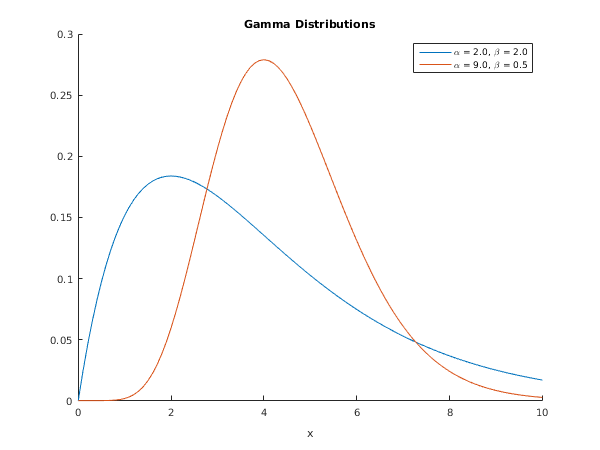PDF version (NAG web site
, 64-bit version, 64-bit version)
NAG Toolbox: nag_stat_pdf_gamma (g01kf)
Purpose
nag_stat_pdf_gamma (g01kf) returns the value of the probability density function (PDF) for the gamma distribution with shape argument and scale argument at a point .
Syntax
Description
The gamma distribution has PDF
If
then an algorithm based directly on the gamma distribution's PDF is used. For values outside this range, the function is calculated via the Poisson distribution's PDF as described in
Loader (2000) (see
Further Comments).
References
Loader C (2000) Fast and accurate computation of binomial probabilities (not yet published)
Parameters
Compulsory Input Parameters
- 1:
– double scalar
-
, the value at which the PDF is to be evaluated.
- 2:
– double scalar
-
, the shape argument of the gamma distribution.
Constraint:
.
- 3:
– double scalar
-
, the scale argument of the gamma distribution.
Optional Input Parameters
None.
Output Parameters
- 1:
– double scalar
The result of the function.
- 2:
– int64int32nag_int scalar
unless the function detects an error (see
Error Indicators and Warnings).
Error Indicators and Warnings
Errors or warnings detected by the function:
If , then nag_stat_pdf_gamma (g01kf) returns .
-
-
Constraint: .
-
-
Constraint: .
-
-
Computation abandoned owing to overflow due to extreme parameter values.
-
An unexpected error has been triggered by this routine. Please
contact
NAG.
-
Your licence key may have expired or may not have been installed correctly.
-
Dynamic memory allocation failed.
Accuracy
Not applicable.
Further Comments
Due to the lack of a stable link to
Loader (2000) paper, we give a brief overview of the method, as applied to the Poisson distribution. The Poisson distribution has a continuous mass function given by,
The usual way of computing this quantity would be to take the logarithm and calculate,
For large and , and are very large, of the same order of magnitude and when calculated have rounding errors. The subtraction of these two terms can therefore result in a number, many orders of magnitude smaller and hence we lose accuracy due to subtraction errors. For example for and , and . But calculated with the method shown later we have . The difference between these two results suggests a loss of about 7 significant figures of precision.
Loader introduces an alternative way of expressing
(1) based on the saddle point expansion,
where
, the deviance for the Poisson distribution is given by,
and
For
close to
,
can be evaluated through the series expansion
otherwise
can be evaluated directly. In addition, Loader suggests evaluating
using the Stirling–De Moivre series,
where the error
is given by
Finally
can be evaluated by combining equations
(1)–
(4) to get,
Example
This example prints the value of the gamma distribution PDF at six different points
x with differing
a and
b.
Open in the MATLAB editor:
g01kf_example
function g01kf_example
fprintf('g01kf example results\n\n');
x = [0.1, 3, 6, 4, 9, 16];
a = [3, 10, 5, 10, 9, 3.5];
b = [2, 11, 1, 0.1, 0.5, 2.5];
result = x;
fprintf('\n x a b pdf\n');
for i=1:numel(x)
[result(i), ifail] = g01kf( ...
x(i), a(i), b(i));
end
fprintf('%12.4e %12.4e %12.4e %12.4e\n', [x; a; b; result]);
g01kf_plot;
function g01kf_plot
fig1 = figure;
hold on;
a = [2, 9];
b = [2, 0.5];
x = [0:0.1:10];
alpha = '\alpha';
beta = '\beta';
for i=1:2
for j=1:numel(x)
[y{i}(j), ifail] = g01kf( ...
x(j), a(i), b(i));
end
plot(x,y{i});
l{i} = sprintf('%s = %3.1f, %s = %3.1f', alpha, a(i), beta, b(i));
end
legend(l);
xlabel('x');
title('Gamma Distributions');
hold off;
g01kf example results
x a b pdf
1.0000e-01 3.0000e+00 2.0000e+00 5.9452e-04
3.0000e+00 1.0000e+01 1.1000e+01 1.5921e-12
6.0000e+00 5.0000e+00 1.0000e+00 1.3385e-01
4.0000e+00 1.0000e+01 1.0000e-01 3.0690e-08
9.0000e+00 9.0000e+00 5.0000e-01 8.3251e-03
1.6000e+01 3.5000e+00 2.5000e+00 2.0723e-02
PDF version (NAG web site
, 64-bit version, 64-bit version)
© The Numerical Algorithms Group Ltd, Oxford, UK. 2009–2015
